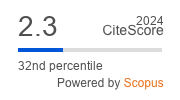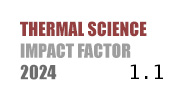ABSTRACT
An argon magnetic fluid is a collection of free charged particles moving in random directions especially that is a weakly ionized argon discharge and on the average, electrically neutral. The 2-D numerical steady-state model of an argon magnetic fluid generator is presented to investigate the thermodynamic behaviors and the distribution of current density. The CFD codes, OpenFOAM, and FLUENT, are utilized in a modified form to model the argon magnetic flow inside the generator. Modeling a thermal magnetic fluid requires a combination of mutually related fluid dynamics and electromagnetic phenomena. With the appropriate thermophysical model, a pressure-based, steady-state, incompressible magnetic fluid solver based on OpenFOAM was originally developed. Meanwhile, FLUENT was expanded upon secondary development functions of user-defined scalar and user-defined function to develop magnetic fluid solution and make reference comparison. The results demonstrated that the numerical simulations obtained with the OpenFOAM solver were in good agreement with those from FLUENT. The highest temperature and velocity were both observed near the cathode region, with the main body temperature exceeding 6000 K. The anode region exerted a compressive effect on the temperature field and accelerated the MHD flow. The current density was primarily distributed in a columnar pattern, concentrated in the cathode region and exponentially decreasing along the axis towards the anode region, with a significant radial gradient.
KEYWORDS
PAPER SUBMITTED: 2024-05-02
PAPER REVISED: 2024-08-07
PAPER ACCEPTED: 2024-08-12
PUBLISHED ONLINE: 2024-08-31
THERMAL SCIENCE YEAR
2025, VOLUME
29, ISSUE
Issue 1, PAGES [579 - 591]
- Ikpe, A. E., et al., Material Selection for High Pressure (HP) Turbine Blade of Conventional Turbojet Engines, American journal of mechanical and industrial engineering, 1 (2016), 1, pp. 1-9
- Lima, R. S., et al., Microstructural Characterization and Room-Temperature Erosion Behavior of As-Deposited SPS, EB-PVD and APS YSZ-Based TBCs, J. of Ther. Spray Tech., 28 (2019), Oct., pp. 223-232
- Benjamin, B., et al., Thermal Insulation Properties of YSZ Coatings: Suspension Plasma Spraying (SPS) vs. Electron Beam Physical Vapor Deposition (EB-PVD) and Atmospheric Plasma Spraying (APS), Surface and Coatings Technology, 318 (2017), May, pp. 122-128
- Padture, N., et al., Thermal Barrier Coatings for Gas-Turbine Engine Applications, Science, 296 (2002), 5566, pp. 280-284
- Alagheband, A., Brown, C., Plasma Atomization Goes Commercial, Metal Powder Report, 53 (1998), 11, pp. 26-28
- Baskoro, A. S., et al. Review on Plasma Atomizer Technology for Metal Powder, MATEC Web of Conferences 269, (2019), 05004
- Lieberman, M. A., Lichtenberg A. J., Principles of Plasma Discharges and Materials Processing, John Wiley & Sons Inc., Hoboken, New Jersey, Canada, 2005
- Chen, F. F., Introduction to Plasma Physics and Controlled Fusion, Springer International Publishing, Cham, Switzerland, 2016
- Chazelas, C., et al., Main Issues for a Fully Predictive Plasma Spray Torch Model and Numerical Considerations, Plasma Chem Plasma Process, 37 (2017), Mar., pp. 627-651
- Li, H. P., Chen, X., Three-Dimensional Modelling of the Flow and Heat Transfer in a Laminar Non-Transferred Arc Plasma Torch, Chinese Physics, 11 (2002), 1, pp. 44-49
- Li, H. P., Pfender, E., Three Dimensional Modeling of the Plasma Spray Process, Journal of Thermal Spray Technology, 16 (2007), May, pp. 245-260
- Hsu, K. C., A Self-Consistent Model for the High Intensity Free-Burning Argon Arc, Ph. D. thesis, University of Minnesota, Minneapolis, Minn., USA, 1982
- Chen, X., Thermal Plasma Heat Transfer and Flow (in Chinese), China Science Publishing & Media Ltd, Beijing, China, 2009
- Yin, Z., et al. Experimental and Numerical Analysis of a Reverse-polarity Plasma Torch for Plasma Atomization, Plasma Chemistry and Plasma Process, 41 (2021), May, pp. 1471-1495
- Sun, J. H., et al. Two-Temperature Chemical Non-equilibrium Modeling of Argon DC Arc Plasma Torch, Plasma Chemistry and Plasma Process 40 (2020), Aug., pp. 1383-1400
- Sass-Tisovskaya, M., Plasma arc Welding Simulation with OpenFOAM, Licentiate of Engineering, Chalmers University of Technology, Gothenburg, Sweden, 2009
- Godinaud N., et al. Development of a new OpenFOAM Solver for Plasma Cutting Modeling, Computers & Fluids, 241 (2022), 105479
- Huang, R., et al., Simulation of Arc Root Fluctuation in a DC Non-Transferred Plasma Torch with Three Dimensional Modeling, Journal of Thermal Spray Technology, 21 (2012), Dec., pp. 636-643
- Perambadur, J., et al., The Investigation of Arc Fluctuations in Thermal Plasma Torch Using 3D Modeling Approach, International Journal of Heat and Mass Transfer, 165 (2021), 120666
- Boulos, M. I., et al. Handbook of Thermal Plasmas, Springer Int. Publishing, Cham, Switzerland, 2023
- Choquet, I., ThermophysicalModels Library in OpenFOAM-2.3.x How to Implement a New Thermophysical Model, www.tfd.chalmers.se/~hani/kurser/OS_CFD_2014/isabelleChoquet/thermophysicalModels-OF-2.3-updated_HN141009.pdf
- Trelles, J. P., et al. Multiscale Finite Element Modeling of Arc Dynamics in a DC Plasma Torch, Plasma Chem Plasma Process, 26 (2006), Sept., pp. 557-575
- Alaya, M., et al. Arc-Cathode Coupling in the Modeling of a Conventional DC Plasma Spray Torch, Journal of Thermal Spray Technology, 24 (2015), Oct., pp. 3-10
- Jasak, H., OpenFOAM: Open Source CFD in Research and Industry, International Journal of Naval Architecture and Ocean Engineering, 1 (2009), 2, pp. 89-94
- Jasak, H. Error Analysis and Estimation for the Finite Volume Method with Applications to Fluid-Flows, Ph. D. thesis, Imperial College, London, UK, 1996
- Bai, Y., et al., High Performance Nanostructured ZrO2 Based Thermal Barrier Coatings Deposited by High Efficiency Supersonic Plasma Spraying, Applied Surface Science, 257 (2011), 16, pp. 7210-7216
- Xi, H., et al. Microstructure and Mechanical Properties of Mo Coating Deposited by Supersonic Plasma Spraying, International Journal of Refractory Metals and Hard Materials, 86 (2020), 105095

